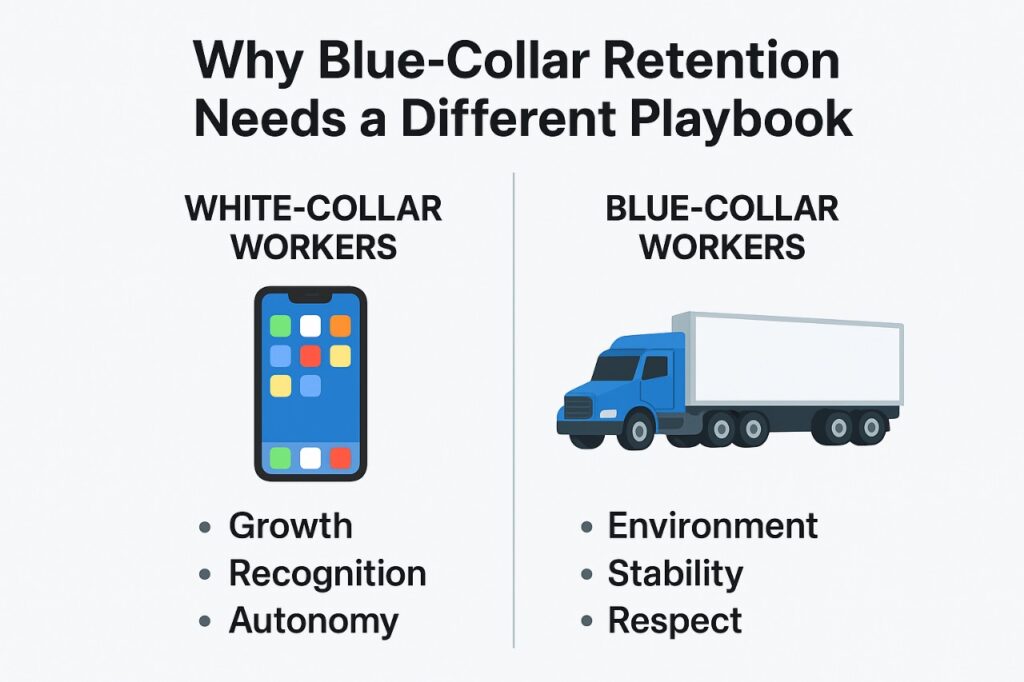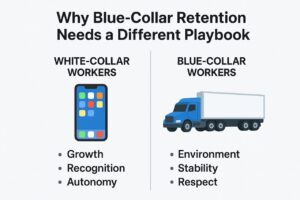
Business owners often misapply white-collar retention tactics to blue-collar teams. Here’s how to motivate them differently — and keep them loyal.
If you run a business with a large blue-collar workforce, I’m guessing you’ve faced some of these frustrations:
- “My workers don’t show discipline.”
- “They lack motivation.”
- “No matter what I do, accountability is low.”
Sound familiar? You’re not alone. Most business owners I speak with share the same concerns. But here’s the catch: it’s not really about the people — it’s about how we manage and motivate them.
Too often, companies use the same benchmarks for white-collar and blue-collar employees. And that’s where things go wrong.
White-Collar vs. Blue-Collar: They’re Playing Different Games
Let’s use a simple analogy.
👉 White-collar employees are like smartphones. They want constant upgrades — new features, better performance, career progression. If they stop getting updates, they switch to a new “model” (another job).
👉 Blue-collar employees are more like trucks. They don’t need fancy features. What they want is reliability — fair pay, safe working conditions, and respect. If you don’t maintain the truck properly, it breaks down.
See the difference? Yet many companies try to “motivate” both groups with the same playbook — and then wonder why it’s not working.
What White-Collar Employees Value
For your office staff, retention is about:
- Growth opportunities (clear career paths, promotions, certifications)
- Recognition and autonomy (being trusted to make decisions)
- Flexibility (hybrid work, flexible hours)
If you don’t provide growth, they feel stuck — and that’s when they leave.
What Blue-Collar Employees Value
For your shop-floor staff, it’s a completely different story. They care more about:
- Work environment (safety, clean facilities, working equipment)
- Fair treatment (predictable schedules, no favoritism, respectful supervisors)
- Stability (reliable wages, job security, consistent hours)
They’re not waiting for a leadership training program or a career map. They want to know:
- “Is my workplace safe?”
- “Do I get treated fairly?”
- “Can I count on this job to support my family?”
Why Businesses Get It Wrong
Here’s a real example: I once worked with a factory owner who was frustrated because his workers kept quitting. He tried everything — incentive bonuses, training sessions, even free lunch Fridays.
But turnover stayed high.
When we dug deeper, the real issues were:
- Machines that kept breaking down
- Last-minute schedule changes that made family life impossible
- Supervisors who barked orders instead of communicating respectfully
No training program was ever going to fix that. Once he focused on stability, safety, and fairness, turnover dropped dramatically.
How You Can Motivate Blue-Collar Teams Differently
Here are a few practical steps you can start with:
✅ Fix the basics first: Safe equipment, clean facilities, and clear processes.
✅ Respect their time: Stick to schedules, minimize last-minute changes.
✅ Train supervisors in people skills: A respectful foreman motivates more than a new bonus scheme.
✅ Recognize contributions: A simple “thank you” or public shout-out means more than you think.
The Bottom Line
White-collar workers stay when they see growth.
Blue-collar workers stay when they feel respected and secure.
If you’re using the same yardstick for both, you’ll keep running into problems. But once you tailor your approach, you’ll see a huge shift: discipline improves, accountability rises, and turnover drops.
At the end of the day, every worker — whether at a desk or on the factory floor — is asking the same question:
👉 “Does this company really care about me?”
Answer that in a way that makes sense to them, and you won’t just have employees. You’ll have loyalty.




































































